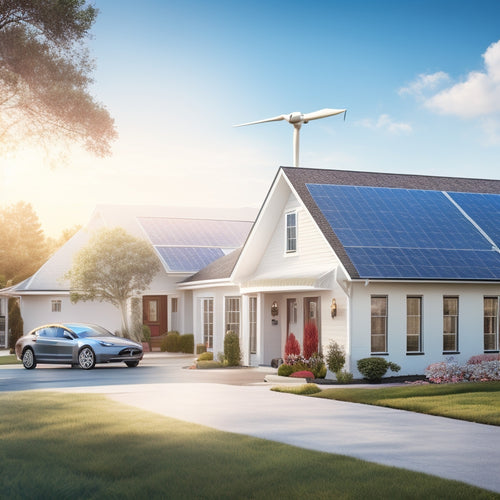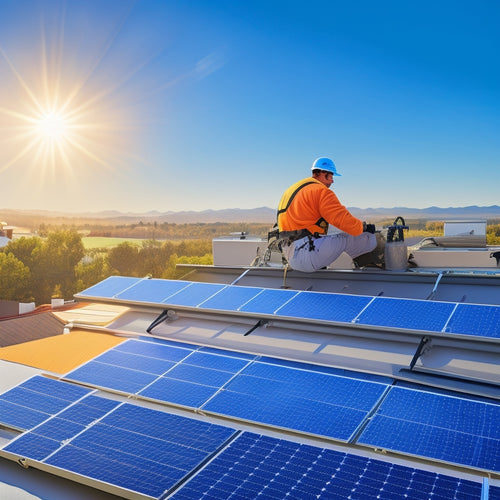
What Does Solar Energy Inverter Do?
Share
You use a solar energy inverter to convert the DC power generated by your solar panels into usable AC power for your home, integrating your renewable energy system with the electrical grid. The inverter optimizes energy output by converting DC power to AC power using advanced algorithms, ensuring a stable AC waveform. It also tracks energy production in real-time, providing performance alerts and data visualization to help you make informed decisions about your energy usage. As you investigate your solar energy system further, you'll uncover how the inverter's additional features, such as grid connection benefits and safety protocols, work together to maximize your energy independence.
Key Takeaways
- Solar energy inverters convert DC power from solar panels into AC power for home use, enabling integration with the electrical grid.
- Inverters optimize energy output by tracking performance, monitoring temperature, and adjusting algorithms to enhance energy production and stabilize AC waveform.
- They provide real-time energy monitoring and management, tracking energy output and adjusting flow to match grid requirements, promoting energy independence and reducing waste.
- Solar energy inverters enable grid connection, synchronizing output with grid frequency and voltage, and allowing excess energy to be fed back into the grid.
- They ensure safety, reliability, and power quality by monitoring temperature, voltage, and current, preventing electrical hazards, and regulating power output to prevent waveform distortion.
How Solar Energy Inverter Works
Typically, a solar energy inverter converts the DC power generated by your solar panels into AC power that's usable in your home. This process is essential for solar panel integration, as it enables you to utilize the energy produced by your solar panels and feed it into your electrical grid.
There are several inverter types, including string inverters, central inverters, and microinverters, each with its own strengths and weaknesses. String inverters are the most common type, suitable for residential and small commercial systems. Central inverters, on the other hand, are ideal for large-scale commercial and utility-scale solar farms. Microinverters, which are installed under each solar panel, offer maximum flexibility and monitoring capabilities.
Regardless of the inverter type, its primary function remains the same: to convert DC power into usable AC power. By understanding how your solar energy inverter works, you can optimize your solar panel integration and maximize your energy output.
Converting DC Power to AC
Your solar energy inverter's primary function is to convert the DC power generated by your solar panels into usable AC power, and this process is vital for feeding energy into your electrical grid.
This DC conversion process involves the inverter using advanced algorithms to enhance energy output and guarantee a stable AC waveform.
There are different inverter types, including string inverters, microinverters, and power optimizers, each with its own efficiency ratings and benefits.
When selecting an inverter, consider its efficiency ratings, as higher ratings translate to less power loss.
Proper installation guidelines must be followed to guarantee system compatibility and ideal performance.
Regular maintenance tips, such as cleaning and inspecting the inverter, can help prevent component failures.
Performance testing is essential to verify the inverter is functioning correctly, and voltage regulation is critical to prevent damage to your electrical system.
Maximizing Solar Panel Efficiency
To maximize solar panel efficiency, one vital aspect is optimizing the panel's operating temperature, as high temperatures can greatly decrease energy output.
You can achieve this by making certain your solar panels are installed at an angle that allows for adequate airflow and by using a cooling system, such as a solar panel cooling fan or a water-based cooling system.
Regular solar panel maintenance is also essential, as dirt and debris can reduce energy output. You should clean your solar panels regularly, ideally every 6-12 months, to remove dirt and debris.
Additionally, you can increase energy efficiency by trimming trees or removing obstructions that cast shade on your solar panels.
Monitoring Energy Production Real-time
You'll want to track your solar energy inverter's performance in real-time to guarantee peak energy output.
This involves monitoring energy output tracking, which provides a precise measurement of the energy your system is producing at any given moment.
Through real-time data display and performance alerts generation, you'll be able to identify and address any issues promptly, maximizing your system's efficiency.
Energy Output Tracking
The solar energy inverter's energy output tracking feature enables real-time monitoring of energy production, providing instant access to essential performance data. This means you can keep a close eye on your solar panel system's performance, identifying areas where energy efficiency can be improved.
By tracking energy output, you'll be able to pinpoint potential issues, such as underperforming panels or inverters, and address them promptly. This level of precision is fundamental in maximizing your system's energy efficiency and minimizing its environmental impact.
You'll be able to monitor energy production in real-time, tracking key metrics such as voltage, current, and power output. This data will help you optimize your system's performance, ensuring that you're generating the maximum amount of clean energy possible.
With energy output tracking, you'll have the understanding you need to make data-driven decisions, reducing energy waste and increasing your return on investment. By leveraging this feature, you'll be able to reveal the full potential of your solar panel system, minimizing your environmental footprint while maximizing your energy savings.
Real-time Data Display
Every kilowatt-hour of energy produced by your solar panel system is essential, and the real-time data display feature of your solar energy inverter guarantees you're always aware of your system's performance.
This feature provides you with instant access to your system's energy production, allowing you to monitor your energy output in real-time. With real-time analytics, you can visualize your energy production and identify areas for optimization.
The data visualization capabilities of your solar energy inverter enable you to view detailed graphs and charts of your energy production, including daily, weekly, and monthly totals.
You can also track your system's performance over time, identifying trends and patterns that can help you maximize your energy output.
This level of transparency and control enables you to make informed decisions about your energy usage and optimize your system's performance for maximum efficiency.
Performance Alerts Generation
Several factors can affect your solar panel system's performance, and that's why your solar energy inverter's performance alerts generation feature is essential. This feature enables real-time performance monitoring, allowing you to stay on top of your system's energy production. You'll receive instant notifications when your system's performance deviates from expected levels, ensuring you can address issues promptly.
The performance alerts generation feature is integrated into the inverter's monitoring system. It continuously tracks your system's energy production, comparing it to expected levels based on factors like weather conditions, system configuration, and historical data. When the system detects an anomaly, it triggers an alert, notifying you of the issue. This enables you to take corrective action, minimizing downtime and maximizing energy production.
With performance alerts generation, you can rest assured that your solar panel system is operating at peak efficiency. You'll receive alerts via email, SMS, or mobile app notifications, ensuring you're always informed and in control.
This feature is critical for optimizing your system's performance, reducing maintenance costs, and ensuring you're generating the maximum amount of clean energy possible.
Providing Grid Connection Benefits
Grid connection benefits arise from the inverter's ability to synchronize its output with the grid's frequency and voltage, allowing you to feed excess energy back into the grid and offset your energy consumption during periods of low solar production.
This synchronization enables you to achieve grid independence benefits, reducing your reliance on the grid and lowering your energy bills. By feeding excess energy back into the grid, you can also monetize your renewable energy integration, generating revenue through net metering or feed-in tariffs.
The inverter's grid connection capabilities also enable you to manage your energy consumption more efficiently. During periods of high solar production, you can store excess energy in the grid, reducing your energy consumption during peak hours.
This not only reduces your energy bills but also helps to stabilize the grid by reducing peak demand. By providing a seamless interface between your solar array and the grid, the inverter plays a critical role in promoting renewable energy integration and reducing your carbon footprint.
Enabling Energy Storage Systems
You'll need to manage energy flow between your solar array, energy storage system, and the grid to optimize performance and guarantee a stable supply of power.
To achieve this, you'll need an inverter that can optimize system performance by controlling the flow of energy and maximizing self-consumption.
Managing Energy Flow
Most modern solar energy systems rely on inverters to manage energy flow, guaranteeing a seamless interaction between the photovoltaic (PV) array, the energy storage system, and the grid. You need to regulate the flow of energy efficiently to maximize your system's performance. This is where the inverter's energy management capabilities come into play.
The inverter continuously monitors the energy output from the PV array and adjusts the flow to match the grid's requirements. It also guarantees that the energy storage system is charged or discharged accordingly, preventing overcharging or undercharging.
The inverter's flow regulation capabilities are critical in preventing grid instability and guaranteeing a smooth shift between different energy sources. By managing energy flow, the inverter enables you to optimize your energy usage, reduce waste, and increase your overall energy independence.
In addition, the inverter's advanced energy management features allow you to prioritize energy usage, allocating excess energy to charge your energy storage system or feed it back into the grid. This level of control and precision is essential for maximizing the benefits of your solar energy system.
Optimizing System Performance
As the inverter efficiently manages energy flow, it's equally important to enhance your solar energy system's performance by integrating energy storage systems. This integration enables you to store excess energy generated during the day for use during periods of low solar irradiance or at night. By doing so, you can considerably improve the overall efficiency of your system.
To achieve ideal system performance, consider the following:
-
Efficiency optimization: Verify that your energy storage system is designed to minimize energy losses during charging and discharging. This can be achieved through the selection of high-efficiency batteries and inverters.
-
System integration: Integrate your energy storage system with your solar energy system to guarantee seamless communication and control. This enables the inverter to optimize energy flow between the solar array, energy storage system, and the grid.
-
Real-time monitoring: Implement real-time monitoring and control systems to track your energy production and consumption. This allows you to identify areas of inefficiency and make data-driven decisions to enhance your system's performance.
Ensuring Grid Compliance
Since energy storage systems are designed to interact with the grid, guaranteeing grid compliance is fundamental to avoid any disruptions or safety hazards.
As you integrate your energy storage system with the grid, you must ascertain it meets the relevant grid standards and regulatory compliance requirements. This involves implementing safety protocols to prevent electrical shocks, fires, or other hazards.
You'll also need to establish interconnection agreements with your utility company, outlining the terms of grid connection and energy exchange.
Your solar energy inverter plays an essential role in maintaining voltage regulation, frequency stability, and power factor within the acceptable range. This facilitates seamless grid integration and system interoperability.
Utility coordination is also significant to confirm that your energy storage system doesn't disrupt the grid's operation or compromise power quality.
Enhancing Safety and Reliability
With the increasing adoption of solar energy systems, guaranteeing the safety and reliability of these installations has become paramount. As you integrate solar energy into your power infrastructure, you need to ascertain that your system is protected from potential hazards.
A solar energy inverter plays a critical role in enhancing safety and reliability by incorporating various features that prevent accidents and guarantee continuous operation.
Some of the key features that contribute to enhanced safety and reliability include:
-
Fire prevention: The inverter is designed to prevent electrical fires by monitoring temperature, voltage, and current levels, and shutting down the system in case of an anomaly.
-
Surge protection: The inverter includes surge protection devices that absorb voltage spikes and transients, protecting the system from damage and guaranteeing continuous operation.
-
Ground fault detection: The inverter detects ground faults and interrupts the circuit to prevent electrical shocks and fires.
Improving Power Quality and Grid Stability
In parallel with guaranteeing safety and reliability, a solar energy inverter must also improve power quality and grid stability. As you connect your solar panel system to the grid, it's imperative that the inverter regulates the power output to prevent waveform distortion and harmonics. This is achieved through advanced harmonics management and power factor correction, confirming that the energy fed into the grid meets the required standards.
The inverter's voltage regulation and frequency stabilization capabilities also play a significant role in maintaining grid stability. By actively adjusting the output voltage and frequency, the inverter assures that the power supplied aligns with the grid's requirements, preventing frequency fluctuations and voltage drops.
Load balancing and reactive power management further enhance the inverter's ability to stabilize the grid, reducing the strain on the electrical infrastructure.
As you optimize your solar energy system for maximum energy efficiency, the inverter's demand response capabilities come into play. By responding to changes in grid demand, the inverter helps maintain grid interconnectivity, guaranteeing a stable and efficient supply of renewable energy.
Frequently Asked Questions
Can I Use a Solar Energy Inverter With a Wind Turbine System?
You can integrate a solar inverter with a wind turbine system, but you'll need to verify compatibility by selecting an inverter specifically designed for hybrid solar-wind systems, allowing seamless power conversion and grid synchronization.
How Often Should I Replace My Solar Energy Inverter?
As you're probably aware, your solar energy inverter's lifespan is around 10-15 years, but with regular maintenance, you can extend it; ideally, you should replace it every 12-13 years, or when its efficiency drops below 80%, to guarantee peak power output.
Are Solar Energy Inverters Suitable for Residential or Commercial Use?
You'll find solar energy inverters suitable for both residential and commercial use, offering distinct benefits: residential options provide efficient energy harvesting for homes, while commercial benefits include scalable systems for large-scale power generation and reduced energy costs.
Can I Connect Multiple Inverters to a Single Solar Panel Array?
When you're cooking with gas, you want maximum energy harvest! You can connect multiple inverters to a single solar panel array, but make certain inverter configurations are compatible with your array's specs to avoid power losses and optimize performance.
Do Solar Energy Inverters Work During a Power Outage?
During a power outage, you can get backup power from your solar energy inverter, but it depends on the inverter's functionality; some models, like grid-tie inverters with backup capabilities, can provide power, while others won't, so you'll need to choose the right inverter for your needs.
Related Posts
-

Top Online Stores for Solar Car Accessories
When searching online for solar car accessories, you'll find top retailers like Amazon, REI Co-op, and Best Buy offer...
-

Why Homeowners Are Embracing DIY Energy Independence
By taking control of your energy needs, you're breaking free from the uncertainty of utility bills and embracing a se...
-

3 Essential Steps for Solar Electricity Installation
To guarantee a successful solar electricity installation, you'll need to follow three essential steps. First, assess ...


